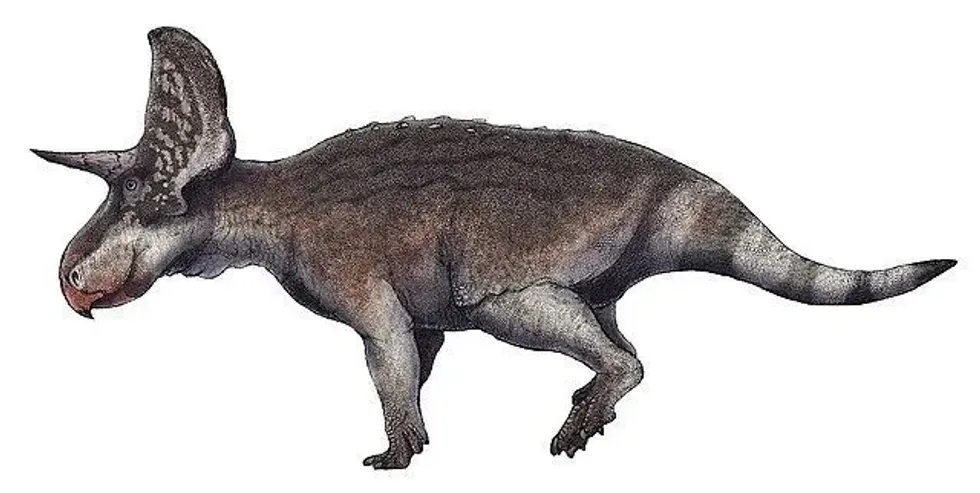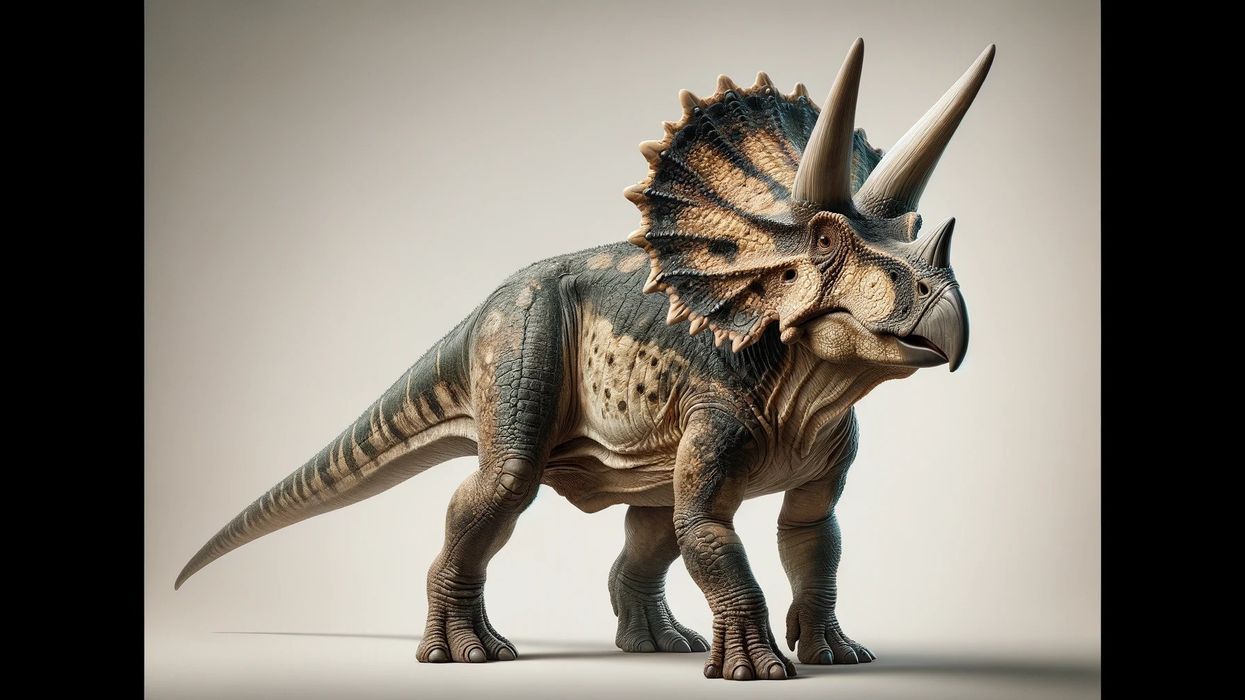Turanoceratops (Turan horned face) is an extinct genus that comprises a ceratopsian dinosaur species that existed in Uzbekistan's Bissekty Formation during the Turonian stage of the Late Cretaceous. It consists of only one species, T. tardabilis, whose fossils date back to 90 million years ago and are believed to be from the mid-late Turonian stage.
The name of this genus originates from 'Turan' which is a Persian name for the Turkistan area of Central Asia and, the Greek word 'cera' that means horn, and the Greek word 'ops' that means face. The specific name 'tardabilis' of the type species is a Latin term and means 'that renders slow'.
It was named in 1989 by G. O. Cherepanov, L. F. Kaznyshkina, and L. A. Nessov. It belongs to the clade Dinosauria, suborder Ceratopsia, and the order Ornithischia.
It is a member of the superfamily Ceratopsoidea. It was considered nomen dubium in 2014 by Peter Dodson but was later considered to be a valid taxon in 2009 by Hans-Dieter Sues.
The discovery of the Turanoceratops fossils started in the 1920s and consisted of fragmented remains. Its length is estimated at 6.5 ft (2 m) and weight at 385.8 lb (175 kg) by researchers.
It was an early quadrupedal (walked on four feet) ceratopsian dinosaur. Its size is quite similar to that of the Zuniceratops.
It had double-rooted teeth present and two to three teeth present in its vertical dental file. It was a herbivore that fed upon plants only.
Enjoyed reading these fun facts? Keep reading to discover Turanoceratops thrilling facts about its discovery, fossil remains, pronunciation, and more!
If you enjoyed reading our interesting Turanceratops facts, you must check out our roar-some facts about the Dryosaurus and Ornithomimus interesting facts!
Turanoceratops Interesting Facts
How do you pronounce 'Turanoceratops '?
The name Turanoceratops originated from the Persian name of the Turkistan area of Central Asia and from two Greek terms 'cera' and 'ops'. This name was given by G. O. Cherepanov, L. F. Kaznyshkina, and L. A. Nessov in 1989. It can be pronounced as 'Tu-ran-o-se-rah-tops'.
What type of dinosaur was a Turanoceratops?
Turanoceratops is a genus consisting of ceratopsian dinosaur species. It was named in 1989 by G. O. Cherepanov, L. F. Kaznyshkina, and L. A. Nessov, and belongs to the clade Dinosauria and the superfamily Ceratopsoidea.
It is considered to be more advanced than Zuniceratops (a genus consisting of the earliest horned dinosaur) but is not advanced enough to be placed in the family Ceratopsidae.
It is believed by researchers that Turanoceratops was a transitional dinosaur that linked advanced ceratopsids like Styracosaurus and Triceratops with primitive ceratopsians of Ceratopsoidea.
It was considered nomen dubium in 2014 by Peter Dodson. However, Dodson was proven wrong as the genus was later considered to be a valid taxon in 2009 by Hans-Dieter Sues. Turanoceratops tardabilis was the first ceratopsoid dinosaur found in Asia.
In which geological period did the Turanoceratops roam the earth?
These dinosaurs existed during the Turonian stage of the Late Cretaceous in Asia.
When did the Turanoceratops become extinct?
It has been estimated that the Turanoceratops (Turan horned face) of the Turonian stage of the Late Cretaceous went extinct 66 million years ago. All species of ceratopsians also went extinct at about the same time.
Where did a Turanoceratops live?
The fossil remains of this genus were discovered in fragments starting from the 1920s in Central Asia. Soviet scientists discovered fragmented fossils of this genus in the Bissekty Formation of the district Navoi Viloyat near Dzharakuduk, Uzbekistan, insinuating that a ceratopid is present.
What was a Turanoceratops's habitat?
These Late Cretaceous period dinosaurs are considered to have inhabited low-lying terrestrial habitats.
Who did a Turanoceratops live with?
These dinosaurs from Asia are believed to have co-existed in the same ecosystem as oviraptorosaurs, ankylosaurs, hadrosaurs, dromaeosaurs, troodontids, ornithomimosaurs, and Mesozoic reptiles like azhdarchid pterosaurs.
How long did a Turanoceratops live?
The lifespan of these dinosaurs of the clade Dinosauria is not yet known. However, we do know that it has been estimated that their relatives, Triceratops, had a lifespan of 40-73 years.
How did they reproduce?
These Late Cretaceous period ceratopsids reproduced by laying eggs. However, the reproduction process of these dinosaurs is not yet known in detail.
Turanoceratops Fun Facts
What did a Turanoceratops look like?

Turanoceratops is estimated to have attained a length of 6.5 ft (2 m) and weighed about 385.8 lb (175 kg). It is quite similar to Zuniceratops as compared to other genera.
In 2009, paleontologist Sues determined some basal features in this dinosaur, suggesting a lower position in the tree of evolution, and a few derived features, indicating a high position.
It had basal traits such as the tooth crowns possessing variably developed ridges and having only two to three teeth on each tooth position. It had derived traits, relative to the basal Zuniceratops, like having two roots for each tooth.
General derived traits were also present.
From the eye socket's upper rim, there was an exclusion of the frontal bone and there were incipient cavities present in the roof of the Turanoceratops skull. It also had well-developed horns situated above its eye socket.
However, the nasal horn was absent in this dinosaur.
Its skull possessed two long brow horns that are similar to those found in the Ceratopsidae family member, but it is still not a member of this family as it is considered to be a transitional dinosaur between ceratopsids and earlier ceratopsians.
Turanoceratops tardabilis is the first ceratopsid dinosaur whose fossils have been excavated from Asia, from Dzharakuduk's Bissekty Formation (Upper Cretaceous), in Uzbekistan.
How many bones did a Turanoceratops have?
The discovery of the fossil remains started in the 1920s and consisted of fragmented remains like a tooth-bearing bone of the upper jaw, and left jaw bone. Authentic material comprises teeth brow horn cores, limb elements, and a skull. The skull had two long brow horns that are similar to those present in the Ceratopsidae family.
How did they communicate?
It isn't known how these dinosaurs communicated with each other. However, we do know that ceratopsids are assumed to have communicated through visual displays.
How big was a Turanoceratops?
The Turanoceratops was quite small. It is estimated to have attained only a length of 6.5 ft (2 m). Its length is double the length of the Pisanosaurus.
How fast could a Turanoceratops move?
The speed of this dinosaur is not yet evaluated. However, it has been estimated that their relative, the Triceratops, moved at a speed of 20 mph (32.1 kph).
How much did a Turanoceratops weigh?
The Turanoceratops dinosaur is estimated to have weighed about 385.8 lb (175 kg).
What were the male and female names of the species?
There are no sex-specific names assigned to the males or females of this species.
What would you call a baby Turanoceratops?
The baby of the species of this genus can be called a hatchling or a juvenile.
What did they eat?
These dinosaurs were herbivores and fed on readily available low-lying vegetation.
How aggressive were they?
Turanoceratops dinosaurs did not prey upon other animals and are believed to have not been aggressive. However, given their weight and the presence of horns, it is assumed that they could have defended themselves well from medium-sized dinosaurs.
Did you know...
The paleontologist Lev Aleksandrovich Nessov in 1988 published the name Turanoceratops tardabilis after its discovery but did not give a description. Until 1989, it remained a nomen nudum!
Were Turanoceratops found in North America?
No, Turanceratops was not found in North America. However, it belonged to Ceratopsia (meaning horned face) that consisted of dinosaurs possessing beaks similar to those of parrots, which lived in North America.
What animals lived with Turanoceratops?
These dinosaurs from Asia are believed to have co-existed in the same ecosystem as oviraptorosaurs, ankylosaurs, hadrosaurs, dromaeosaurs, troodontids, ornithomimosaurs, and Mesozoic reptiles like azhdarchid pterosaurs.
Here at Kidadl, we have carefully created lots of interesting family-friendly dinosaur facts for everyone to discover! For more relatable content, check out these Velocipes facts and Melanorosaurus facts for kids.
You can even occupy yourself at home by coloring in one of our free printable Turanoceratops coloring pages.
Main image by Deviant Art.
Second image by Michael B. H.









